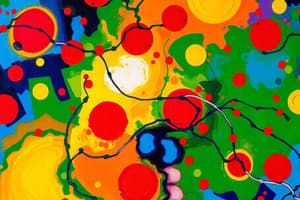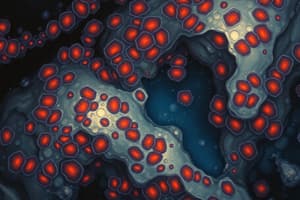Podcast
Questions and Answers
Which of the following best describes the role of voltage-dependent calcium channels in skeletal muscle contraction?
Which of the following best describes the role of voltage-dependent calcium channels in skeletal muscle contraction?
- They maintain a constant level of calcium in the cytoplasm, preventing both contraction and relaxation.
- They respond to changes in membrane polarity, leading to increased cytoplasmic calcium and muscle contraction. (correct)
- They facilitate the pumping of calcium into the sarcoplasmic reticulum, promoting muscle relaxation.
- They decrease cytoplasmic calcium levels, leading to muscle relaxation.
In cardiac muscle cells, which mechanism, in addition to those found in skeletal muscle, contributes to the regulation of calcium concentration and, consequently, muscle contraction and relaxation?
In cardiac muscle cells, which mechanism, in addition to those found in skeletal muscle, contributes to the regulation of calcium concentration and, consequently, muscle contraction and relaxation?
- Antiport systems linked to sodium-potassium pumps. (correct)
- Sodium-independent calcium channels.
- Increased storage capacity of the sarcoplasmic reticulum.
- Direct uptake of calcium from the extracellular space via endocytosis.
How do sodium/potassium pumps contribute to glucose absorption in intestinal epithelial cells?
How do sodium/potassium pumps contribute to glucose absorption in intestinal epithelial cells?
- They facilitate glucose diffusion through the GLUT2 transporter.
- They directly transport glucose into the cell.
- They create the sodium gradient necessary for the SGLT1 symporter to function. (correct)
- They actively transport glucose out of the epithelial cell.
In Glucose-Galactose Malabsorption (GGM), why does the accumulation of glucose and galactose in the intestines lead to watery diarrhea?
In Glucose-Galactose Malabsorption (GGM), why does the accumulation of glucose and galactose in the intestines lead to watery diarrhea?
Why can individuals with Glucose-Galactose Malabsorption (GGM) typically consume fructose without experiencing the same symptoms as when they consume glucose or galactose?
Why can individuals with Glucose-Galactose Malabsorption (GGM) typically consume fructose without experiencing the same symptoms as when they consume glucose or galactose?
A newborn presents with severe watery diarrhea, dehydration, and abdominal bloating shortly after being fed breast milk. The symptoms improve when the infant is switched to a fructose-based formula. Which of the following is the most likely underlying cause?
A newborn presents with severe watery diarrhea, dehydration, and abdominal bloating shortly after being fed breast milk. The symptoms improve when the infant is switched to a fructose-based formula. Which of the following is the most likely underlying cause?
Which of the following best describes the primary function of microtubules within a cell?
Which of the following best describes the primary function of microtubules within a cell?
How do actin filaments contribute to cellular processes?
How do actin filaments contribute to cellular processes?
What is the primary role of intermediate filaments in cells?
What is the primary role of intermediate filaments in cells?
Taxanes like paclitaxel are known to disrupt microtubule function. What is the most likely consequence of treating cells with paclitaxel?
Taxanes like paclitaxel are known to disrupt microtubule function. What is the most likely consequence of treating cells with paclitaxel?
Omeprazole inhibits proton pumps in the stomach. What direct effect does omeprazole have on gastric acid production?
Omeprazole inhibits proton pumps in the stomach. What direct effect does omeprazole have on gastric acid production?
What is the immediate consequence of activating the sodium/potassium ATPase (Na+/K+ pump)?
What is the immediate consequence of activating the sodium/potassium ATPase (Na+/K+ pump)?
How does the activity of the sodium/potassium ATPase (Na+/K+ pump) contribute to the function of SGLT1 in the small intestine?
How does the activity of the sodium/potassium ATPase (Na+/K+ pump) contribute to the function of SGLT1 in the small intestine?
What is the functional role of GLUT2 in intestinal glucose absorption following SGLT1 activity?
What is the functional role of GLUT2 in intestinal glucose absorption following SGLT1 activity?
A pathogenic variation in the SCL5A1 gene, encoding SGLT1, impairs its function. What is a likely consequence of this mutation?
A pathogenic variation in the SCL5A1 gene, encoding SGLT1, impairs its function. What is a likely consequence of this mutation?
What is the primary function of actin nucleators like the Arp2/3 complex in actin filament formation?
What is the primary function of actin nucleators like the Arp2/3 complex in actin filament formation?
Which of the following characteristics is unique to intermediate filaments compared to actin filaments and microtubules?
Which of the following characteristics is unique to intermediate filaments compared to actin filaments and microtubules?
How does GTP hydrolysis affect the dynamics of microtubules?
How does GTP hydrolysis affect the dynamics of microtubules?
How does Paclitaxel, a taxane, affect microtubule dynamics and what is the underlying mechanism?
How does Paclitaxel, a taxane, affect microtubule dynamics and what is the underlying mechanism?
Which cellular process directly relies on the dynamic cycles of polarization and depolarization across a membrane?
Which cellular process directly relies on the dynamic cycles of polarization and depolarization across a membrane?
What is the role of FXYD proteins in sodium-potassium pumps?
What is the role of FXYD proteins in sodium-potassium pumps?
How does Omeprazole inhibit proton pumps in parietal cells?
How does Omeprazole inhibit proton pumps in parietal cells?
What is the functional consequence of inhibiting microtubule depolymerization?
What is the functional consequence of inhibiting microtubule depolymerization?
Which of the following cellular activities is NOT directly supported by actin filaments?
Which of the following cellular activities is NOT directly supported by actin filaments?
What contributes to the electrochemical gradient across a cell membrane?
What contributes to the electrochemical gradient across a cell membrane?
Flashcards
Microtubules Function
Microtubules Function
A network forming polarized pathways for organelle and intracellular protein movement.
Actin Filaments Function
Actin Filaments Function
Filaments that generate contractile and protrusive forces inside of cells.
Intermediate Filaments Function
Intermediate Filaments Function
Filaments responsible for maintenance of cell shape and mechanical resistance.
Cytoskeleton
Cytoskeleton
Signup and view all the flashcards
Actin Filaments
Actin Filaments
Signup and view all the flashcards
Microtubules
Microtubules
Signup and view all the flashcards
Intermediate Filaments
Intermediate Filaments
Signup and view all the flashcards
Ion Pumps
Ion Pumps
Signup and view all the flashcards
Ion Channels
Ion Channels
Signup and view all the flashcards
Actin Nucleators
Actin Nucleators
Signup and view all the flashcards
Nucleation Promoting Factors (NPFs)
Nucleation Promoting Factors (NPFs)
Signup and view all the flashcards
Microtubule Dynamics
Microtubule Dynamics
Signup and view all the flashcards
Paclitaxel
Paclitaxel
Signup and view all the flashcards
Electrochemical Gradient
Electrochemical Gradient
Signup and view all the flashcards
Membrane Potential
Membrane Potential
Signup and view all the flashcards
Pumps (Ion)
Pumps (Ion)
Signup and view all the flashcards
Voltage-dependent calcium channels
Voltage-dependent calcium channels
Signup and view all the flashcards
Role of cytoplasmic calcium in skeletal muscle
Role of cytoplasmic calcium in skeletal muscle
Signup and view all the flashcards
Calcium regulation in cardiac muscle
Calcium regulation in cardiac muscle
Signup and view all the flashcards
SGLT1
SGLT1
Signup and view all the flashcards
Sodium/Potassium pump in glucose absorption
Sodium/Potassium pump in glucose absorption
Signup and view all the flashcards
Glucose-Galactose Malabsorption (GGM)
Glucose-Galactose Malabsorption (GGM)
Signup and view all the flashcards
Study Notes
- Study notes on Cytoskeleton, Pumps and Channels
Cytoskeleton Review
- A review of the cytoskeleton is provided with emphasis on structure and function
- The cytoskeleton is comprised of microtubules, actin filaments and intermediate filaments
Microtubules
- Forms polarized network for organelle and protein movement within the cell
- Hollow tubes, 25 nm with 15-nm lumen
- The protein subunit is tubulin, a dimer consisting of α-tubulin and ẞ-tubulin
- Microtubules maintain cell shape and motility
- Functions in chromosome movements in cell division and organelle movements
- Major component of cytoskeleton
- Provides cell shape and support
- Functions in SPINDLE formation during cellular division
- Tracks movement of material within the cell
- Provides for spatial organization of the cell and organelle movement
- Hollow rods are formed from α and β tubulin
- 25 nanometer fiber formed from 13 protofilaments
- Microtubules have orientation (+ and - ends)
- Bound GTP promotes growth; GTP hydrolysis frees dimers
- Found in Flagella and Cilia as a structural component
Actin Filaments
- Responsible for contractile and protrusive forces on cells
- Consists of two intertwined strands of actin
- Diameter of 7 nm
- The protein subunit is actin
- Maintains cell shape and changes in cell shape
- Responsible for muscle contraction, cytoplasmic streaming (plant cells), cell motility and cell division (animal cells)
- Two chains of actin (helix) create actin filaments
- 7 nm fiber with “pointed” and “barbed” ends
- Growth can occur at both ends but net growth tends toward "barbed" end
- Growth/assembly requires ATP; ATP hydrolysis frees monomers shortening the fiber
- Functions include cell shape, motility, cell division (cytokinesis), muscle contraction and cytoplasmic streaming
- Growth/assembly requires ATP; ATP hydrolysis frees monomers shortening the fiber
- Requires actin nucleators (Arp2/3 Complex)
- Frequently the nucleators must associate with nucleation promoting factors (NPFs) which enhances efficiency of polymerization
- Branching of actin filaments requires complexes such as Arp2/3
Intermediate Filaments
- Responsible for maintenance of cell shape
- Fibrous proteins coiled into cables
- Diameter of 8-12 nm
- Protein Subunits are one of several different proteins (such as keratins) such as vimentin, keratin and neurofilaments
- Maintain cell shape
- Responsible for anchorage of nucleus and certain other organelles and formation of nuclear lamina
- Functions include adding strength, bearing tesnsion, reinforcing cell shape and fixing positions of organelles and desmosomes
- Most diverse component of the cytoskeleton
- 8 to 12 nm thick INSOLUBLE fibers
- Seven amino acid pseudo-repeat sequence with specific localization of non-polar groups to form strip of hydrophobicity down axis of helix
Microtubule dynamics
- GTP binding triggers polymerization while GTP hydrolysis triggers depolymerization
- Microtubule associated proteins regulate growth, stability, and interaction with other cellular components
- Nocodazole interferes with polymerization while paclitaxel stabilizes microtubules
The Taxanes
- Family of compounds that stabilize microtubules by inhibiting depolymerization
- Each family member may impact microtubule associated proteins differently
- Paclitaxel reversibly binds the N-terminal 31 amino acids of the beta-tubulin subunit
- It shifts the equilibrium toward ASSEMBLY
- Microtubules inhibited with paclitaxel cannot depolymerize (lose catastrophe) and affects the number of tubulin heterodimers in microtubules
Pumps and Electro-chemical Gradients
- Electrochemical gradient = difference in electric potential over a distance across a membrane
- Membrane potential = resulting difference in voltage across a membrane
- Pumps are required for generation of electrochemical gradients that enable passive diffusion through an ion channel
- Polarized membranes can be summarized as a differential in charge where one side is positive and the opposite side is negative
- Depolarization shifts the internal negative charge such that the cell becomes less negative
- Cycles of polarization and depolarization = action potentials = transient and reversible
Sodium-Potassium Pumps
- Pumps and channels that regulate ion availability and localization are critical to function
- Wide range of activities are connected to sodium-potassium pumps including movement, entry of glucose into cells, and maintenance of low pH in the stomach
- Pumps are a combination of proteins (tissue specific FXYD proteins) combined with a catalytic α-subunit and obligatory β-subunit -multiple transmembrane segments are present
Proton Pumps
- Hydrogen ions can be released to corresponding environments via proton pumps
- Critical to lowering pH in those environments
- Example of Parietal cell
- Regulation of this process is crucial as chronic secretion of the strong acids by the pump causes gastric and duodenal ulcers
- Treatment: Omeprazole activated by the acidic conditions of the gastric lumen
- Omeprazole Modifies cysteine residues of proton pump thus inhibiting the pump
- Treatment of gastric and duodenal ulcers with a combination of antibiotics and omeprazole is the most effective due to role of H. Pylori in ulcer formation
Role of Calcium Channels in Movement
- Voltage-dependent calcium channels respond to membrane depolarization and thus generate cellular responses following changes in membrane polarity
- Increased cytoplasmic calcium from the sarcoplasmic reticulum in skeletal muscle leads to muscle contraction
- Calcium must be pumped out of the cytoplasm back to the sarcoplasmic reticulum for the muscle to relax
- The process in cardiac muscle is similar though those cells also utilize antiport systems for calcium movement linked to sodium-potassium pumps to regulate calcium concentrations and thus responses
Combined symport activity
- Glucose enters intestinal epithelial cells via a symporter called SGLT1 that is coupled to Na+
- Na+ enters cell bringing glucose along
- Sodium or potassium pumps create the gradient that lets sodium naturally diffuse back through the SGLT1 symporter
- Glucose is then transported back out of the epithelial cell via facilitated diffusion mediated by GLUT2
Glucose-Galactose Malabsorption (GGM)
- GGM is a very rare autosomal recessive disorder that can result in neonatal death if untreated and is also known as SGLT1 deficiency
- Pathogenic variation in the SCL5A1 gene that encodes SGLT1 includes missense mutations with variable frequency depending on the population
- Glucose and galactose are not properly absorbed and accumulate in the intestines
- Common symptoms include Neonatal onset of severe life-threatening watery diarrhea and dehydration, bloating, nausea, abdominal cramps, frequent urination, and rumbling sounds from extra gas in the intestines, and is clinically indistinguishable from disaccharidase deficiency
- Treatment includes avoiding foods with glucose or galactose and milk products, but they can consume fructose
- Normal growth and development can occur if caught and treated properly
Studying That Suits You
Use AI to generate personalized quizzes and flashcards to suit your learning preferences.




